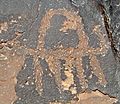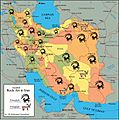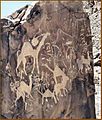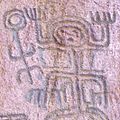Petroglyph facts for kids
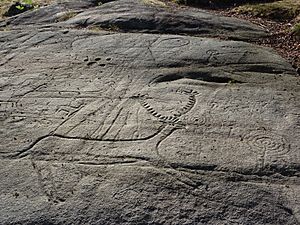
Petroglyphs are amazing ancient artworks carved into rock surfaces. Imagine people long ago using tools to scratch, pick, or carve pictures and symbols onto stones! These carvings are a special kind of rock art.
People outside North America often use words like "carving" or "engraving" to describe these images. Petroglyphs can be found all over the world. They give us clues about the lives of prehistoric people who lived thousands of years ago.
Contents
What Does "Petroglyph" Mean?
The word "petroglyph" comes from ancient Greek. The first part, "petro-", means "stone". It comes from the Greek word petra. The second part, "-glyph", means "to carve". It comes from the Greek word glýphō. So, a petroglyph is literally a "stone carving". The word was first used in French as pétroglyphe.
Where Are Petroglyphs Found?
Petroglyphs are found on every continent except Antarctica. They are like a global art gallery left by our ancestors. These carvings can be found in deserts, mountains, forests, and near rivers. Each location often has unique styles and meanings.
Ancient Art Around the World
Some of the oldest petroglyphs are thought to be from the Upper Paleolithic period. This was about 40,000 years ago! Many others were made during the Neolithic and Bronze Ages. They show us how people lived, hunted, and thought in different parts of the world.
Common Themes in Petroglyphs
What did ancient artists draw? They often carved animals like deer, bighorn sheep, and even mammoths. Human figures, hunting scenes, and mysterious symbols are also common. Some petroglyphs show maps, constellations, or tell stories. They can give us a peek into ancient beliefs and daily life.
How Were Petroglyphs Made?
Ancient artists used different methods to create petroglyphs. They might have used harder stones to peck, cut, or rub away parts of a softer rock surface. Sometimes, they used sharp tools to incise lines. The tools and techniques varied depending on the type of rock and the culture.
Why Are Petroglyphs Important?
Petroglyphs are like messages from the past. They help historians and archaeologists understand ancient cultures. They show us what was important to these people. They also tell us about their environment, their beliefs, and their way of life. Protecting these ancient artworks helps us learn more about human history.
Images for kids
-
Rock carving known as Meerkatze (named by archaeologist Leo Frobenius), rampant lionesses in Wadi Mathendous, Mesak Settafet region of Libya.
-
Reclining Buddha at Gal Vihara, Sri Lanka. The image house that originally enclosed the remains can be seen.
-
Petroglyphs of the archaeological site of Las Labradas, situated on the coast of the municipality of San Ignacio (Mexican state of Sinaloa)
-
Composite image of petroglyphs from Scandinavia (Häljesta, Västmanland in Sweden). Nordic Bronze Age. The glyphs have been painted to make them more visible.
-
A petroglyph of a caravan of bighorn sheep near Moab, Utah, United States; a common theme in glyphs from the desert Southwest and Great Basin
-
Lion Plate at Twyfelfontein in Namibia (2014)
-
Millenarian rock carvings, Laxe dos carballos at Campo Lameiro, this detail depicts a deer hit by several spears
-
Petroglyph Park near Petrozavodsk–Lake Onega, Russia
-
Mammoth on the basalt stone in Sikachi-Alyan, Russia
-
Petroglyph on western coast of Hawaii
-
Modern Hopi have interpreted the petroglyphs at Mesa Verde National Park's Petroglyph Point as depictions of the Eagle, Mountain Sheep, Parrot, Horned Toad, and Mountain Lion clans, and the Ancestral Puebloans who inhabited the mesa
-
Islamic inscriptions, Qasim.
-
Rock carving on Cheung Chau Island, Hong Kong. This 3000-year-old rock carving was reported by geologists in 1970
-
Petroglyphs at Cholpon-Ata in Kyrgyzstan
-
Tamgaly petroglyphs in Kazakhstan
-
Buddhist carvings at Ili River in Kazakhstan
-
Petroglyphs on a rock wall found in the Sierra Madre mountain range, Rizal, Philippines
-
Petroglyph in Roque Bentayga, Gran Canaria (Canary Islands).
-
Petroglyph at Dalgarven Mill, Ayrshire, Scotland.
-
Bronze Age petroglyphs depicting weapons, Castriño de Conxo, Santiago de Compostela, Galicia.
-
Labyrinth, Meis, Galicia.
-
Cup-and-ring mark, Louro, Muros, Galicia.
-
Petroglyph on Tunduqueral hill at Uspallata, Argentina
-
El Abra archaeological site, Cundinamarca
-
Petroglyph in the Chiribiquete Natural National Park. (Possible equine)
-
Petroglyph in the Chiribiquete Natural National Park. Aboriginal
-
Petroglyph in the Chiribiquete Natural National Park. (Possible mammal).
-
Petroglyphs in the Chiribiquete Natural National Park.
-
Petroglyphs on a Bishop Tuff tableland, eastern California
-
Southern Utah
-
Southern Utah
-
Animal print carvings outside of Barnesville, Ohio
-
Rochester Rock Art Panel in the San Rafael Swell in Utah
-
Web-like petroglyph on the White Tank Mountain Regional Park Waterfall Trail, Arizona
-
Chipping petroglyph on the White Tank Mountain Regional Park Waterfall Trail, Arizona
-
Detail of a carved archer-like figure, Sanilac Petroglyphs Historic State Park, Sanilac County, Michigan
-
Ku-ring-gai Chase National Park, New South Wales
-
Part of a 20-metre-long petroglyph at Ku-ring-gai Chase National Park, New South Wales
-
Mutawintji National Park, New South Wales
-
Burrup Peninsula, Western Australia
See also
 In Spanish: Petroglifo para niños
In Spanish: Petroglifo para niños




